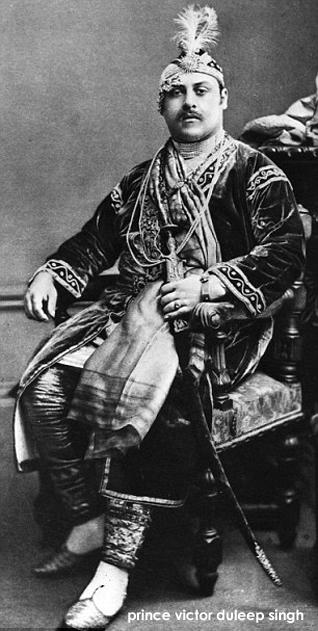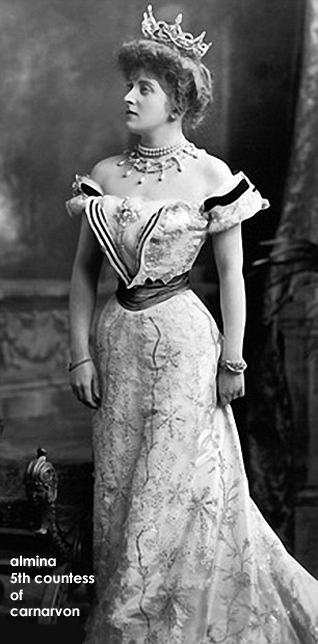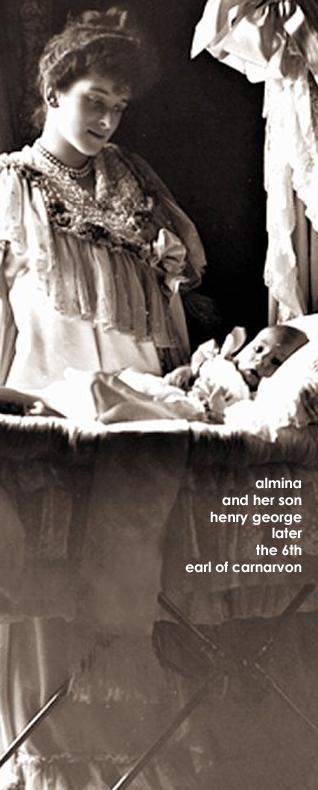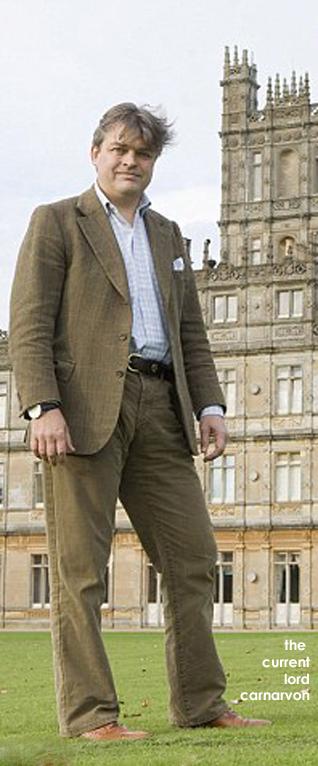History
The Curse of The Kohinoor Continues To Haunt The Brits
by CHRISTOPHER WILSON
THE LIFE AND SECRETS OF ALMINA CARNARVON: 5TH COUNTESS OF CARNARVON, OF TUTANKHAMUN FAME, by William P. Cross. Published by William P. Cross, Unnited Kingdom., 2011, pp 258, paperback. ISBN-10: 1905914024; ISBN-13: 978-1905914029
Now here’s a Downton Abbey storyline that writer Julian Fellowes would dismiss as too far-fetched: that the steely Earl of Grantham of Great Britain has no right to his title and should be booted out of the Abbey to make way for a distant cousin.
Yet, in real life, this could indeed be the case for the poor unassuming 8th Earl of Carnarvon, whose family history has been plundered for the storyline of the top-rated TV series and whose stately home, Highclere Castle, is used as its backdrop.
For new genealogical evidence points to the uncomfortable fact that Lord Carnarvon’s grandfather may well have been the son, not of an English aristocrat, but of a Sikh prince.
Furthermore, there’s evidence that the family knew about it and covered it up. If this is true, it would mean that the present earl, Eton and Oxford-educated George Carnarvon, has no right to his title, and that the privilege should pass to an unassuming 39-year old Devon teacher, Alan Herbert.
The author of a new biography of 55-year old Lord Carnarvon’s great-grandmother has unearthed explosive evidence which could alter the 218-year history of the famous title - and provide Julian Fellowes with some rich source material for the next series of Downton.
But Mr. Cross says that Lord Carnarvon was not deeply attracted to his wife - nor she to him - and that sexual relations may have remained dormant long after their marriage.
Carnarvon’s closest friend was Prince Victor Duleep Singh, a godson of Queen Victoria and the son of Duleep Singh, the last Maharajah of Punjab. Though a Sikh, he was welcome in the very highest echelons of society and was a close friend of King Edward VII.
Victor had been a friend of Carnarvon at Eton and, as they grew up, he led the young Englishman into ‘wild ways’. They gambled ruinously, and while on a trip to Egypt, Victor fixed up the young peer with a prostitute so he could lose his virginity.
‘But Carnarvon contracted a malady from one of the whorehouses, and after returning to England almost died,’ reveals Mr. Cross. ‘He retained for life the facial marks from the effects of the disease. Thereafter, Carnarvon was sexually blighted.
‘His fall-back - with his valet Fernside as his confidant - was taking photographs of women. Naughty pictures became his passion, and at the height of his voyeurism he commissioned 3,000 nudes from a photographic studio.’
If Carnarvon wasn’t interested in his new wife, ten years his junior, then his best friend was. Prince Victor practically lived at Highclere Castle, in Hampshire. ‘He had plenty of opportunity,’ says Mr. Cross. Significantly, when the Countess became pregnant, she made two sets of plans for the birth of her child.
The first, official, plan was to have the baby delivered at the Carnarvon family home in London’s Berkeley Square. But she also rented another house - and for good reason. ‘She was terrified,’ says William Cross. ‘The safe house was her planned refuge - just in case the baby was born with the wrong skin pigment.’
In the event, she gave birth to a son on November 7, 1898 who turned out to be fair-skinned, for though Prince Victor had the dark skin of his race, his mother, Maharani Bamba, was a fair-skinned woman.
Skin colour is believed to be determined by up to seven different genes working together, so as a mixed race man, Prince Victor had a mixture of genes coding for both black and white skin in his sperm - and so had the chance of having white offspring.
In any case, the earl accepted the child as his own, and in so doing averted the inevitable divorce and loss of funds - for it was his wife’s fortune which was to allow him, in a few years’ time, to take his place in history as the man who uncovered the tomb of Tutankhamun. Almina’s riches took care of that.
Regardless of the boy’s skin colour, the peer’s abiding concern was that if it became publicly suspected that he was indeed the son of Prince Victor, it would have had ruinous consequences on the Carnarvon dynasty, and call into question the whole future of Highclere Castle itself. His wife’s closeness with the Sikh Prince had to be hushed up.
And so it was - until about 15 years ago, when the then Earl decided to commission a biography of Almina. The incriminating evidence was uncovered by the Reverend David Sox, an American academic.
‘Just between the two of us,’ Sox wrote to a friend soon after his findings, ‘I’ve discovered (quite by accident in the archives) that the Earl’s real father was Prince Victor. Victor was constantly at Highclere, as going through my visitors’ books indicates.
’Until Sox’s startling claim, the 7th Earl, a close friend of the present Queen and her racing manager from 1969 to 2001, had made well-publicised plans to publish the biography. But as soon as the awful truth was uncovered, the book was dropped and never mentioned again.
Sox was regarded as a reliable historian, according to the long-serving Highclere housekeeper, Maureen Cummins. She says: ‘He came into the castle and did a lot of research. In fact, he was so knowledgeable that he was employed for a time as a guide. So it is highly unlikely he would have made the story up.’
Aristocratic families, beady about their possessions and titles, have learned over centuries how to beat off predators who, throughout history have fed off the rich and famous. The Carnarvons would not want their lands and status to pass to a junior branch of the family - and so the scandal was hushed up, the skeleton put firmly in the back of Highclere Castle’s capacious closets.
William Bortrick, executive editor of Burke’s Peerage, is unfazed by the revelations: ‘Throughout the history of the British aristocracy such circumstances did happen,’ he says. ‘Probably more often than people realised.’
Indeed, among the present ranks of the aristocracy there is at least one Duke and an Earl who are generally known not to be the sons of the men outwardly thought to be their fathers.
‘The only requirement in law is for an hereditary peer, when he succeeds to the title, to produce his birth certificate to prove his identity,’ I was told by another authority. ‘If the certificate falsely claims he is legitimate, and nobody challenges it, he goes through on the nod.’
And so Prince Duleep’s son became an Earl and nobody blinked an eye.
So the question remains - who is the real Earl of Carnarvon?
Step forward, Alan Mervyn Edward Hugh Herbert, a bachelor who celebrates his 40th birthday later this month. Mr. Herbert descends in a direct line from the 4th Earl of Carnarvon, his great-grandfather (and the father of the under-sexed 5th Earl). This Earl married twice, and his son by the second marriage, the Hon Mervyn Herbert, was Alan’s grandfather.
There are no other male lines of succession in the family apart from Alan and his cousin, the present ‘Earl’. A shy and retiring teacher, he lives in a flat in the large and glorious Devonshire house once owned by his family, another branch of the Carnarvon clan.
When approached by the Daily Mail this week and told that he had a strong claim to be the rightful Earl, he greeted the news with astonishment.
‘Wow,’ he said, very quietly. ‘I was aware we had some kind of connection with the Carnarvons but that is all. This is a big surprise, I must say. I’d be curious to know more.’
Such curiosity could open a hornet’s nest, since quite apart from the titles, there’s the question of Highclere Castle, the Carnarvon estates and a multi-million Downton Abbey legacy at stake.
While it doesn’t automatically follow that if he proves his superior claim to the title, family possessions would pass his way - but they might.
Author William Cross asserts that Almina Carnarvon was made to sign papers attesting to her son’s legitimacy which may well have secured the family’s millions for the present incumbents of Highclere Castle, but often lawyers have a way of finding loopholes in such deeds, particularly if the truth had not been told.
It is too early yet for the bewildered Mr. Herbert to pursue his claim to the earldom, but the door is open for him to do so.
‘As a matter of decency and courtesy it’s usual to wait for the death of a peer before making a competing claim,’ says Ian Denyer, a Crown Office constitutional expert based at the Palace of Westminster.
‘But there’s no reason, if he wanted to ruffle some feathers, why he shouldn’t go ahead now.’
The difficulty facing Mr. Herbert is that the crucial evidence naming Prince Victor as the father of the 6th Earl resides in the archives at Highclere Castle, where biographer William Cross found it.
Of course, modern science using DNA could prove the truth once and for all. Indeed, the Sikh historian Peter Singh Bance, who has written a biography of Prince Victor Duleep Singh, says that hair from the prince and his younger brother were kept after their deaths.
Matched with DNA from a member of the Carnarvon family, it could be tested to prove if Mr. Herbert is entitled to swap his Devon flat for a stately home in Hampshire.
Ironically, Mr. Herbert has never watched the TV series, Downton Abbey, saying: ‘I did hear something about it on the radio. It sounds like something I should watch.’
If he did, he might see the 1,000-acre estate where the serial is set and consider the fickle nature of the finger of fate.
[Courtesy: The Daily Mail. Edited for sikhchic.com]
October 23, 2011
Conversation about this article
1: Harnam Singh (Singapore), October 23, 2011, 10:39 AM.
Here's yet another responsibility we Sikhs have had to carry through recent times, for the benefit of humanity: the improvement of the gene-pool in the British Isles! It's going to be a long haul, this one ... but somebody's got to do it! And who else is better equipped?
2: Baldev Singh (Bradford, United Kingdom), October 23, 2011, 12:52 PM.
What a fantastically fascinating story! [I am madly fascinated by Egyptology and the eerie Tutankhamun saga involving Lord Carnarvon!] The British took their imperialism and so-called 'Christian values' around the world to subjugate millions but, once back home and left to their own, have been coming unstuck ...
3: N. Singh (Canada), October 23, 2011, 2:02 PM.
How ironic! The British stripped the Sikhs of their King and their Kingdom, and yet Mother Nature has a way of equalizing things! Well done, Prince Victor Duleep Singh!
4: Bhupinder Singh Dokal (London, United Kingdom), November 22, 2011, 12:08 PM.
What is even more ironic is that if the lineage of Prince Victor Duleep Singh is proven, then the current Lord Carnarvon can lay claim to his heritage as the Maharaja of Punjab!






